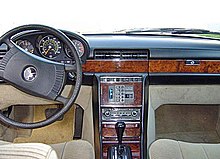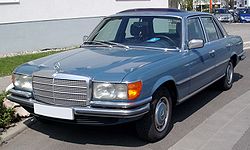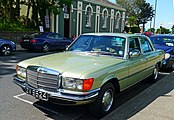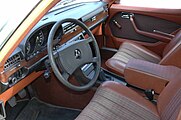Mercedes-Benz 116 series
| Mercedes Benz | |
|---|---|
|
Mercedes-Benz W 116
|
|
| W 116 | |
| Sales designation: | S-class |
| Production period: | 09 / 1972-09 / 1980 |
| Class : | Upper class |
| Body versions : | limousine |
| Engines: |
Otto engines : 2.8–6.9 liters (115–210 kW) Diesel engine : 3.0 liters (85 kW) |
| Length: | 4960-5060 mm |
| Width: | 1870 mm |
| Height: | 1410-1430 mm |
| Wheelbase : | 2860-2965 mm |
| Empty weight : | 1660-1985 kg |
| Previous model | Mercedes-Benz W 108 , Mercedes-Benz W 109 |
| successor | Mercedes-Benz model series 126 |
The Mercedes-Benz 116 series describes the luxury class sedans that what was then Daimler-Benz AG brought onto the market from September 1972.
With this series the term “S-Class” was brought to life; Daimler-Benz itself sees the predecessor W 108 / W 109 as the actual birth of the S-Class. The designation W 116 stands for the sedans, the long version "SEL" is designated as V 116.
The successor model was the 126 series in September 1979 . Some models of the 116 series continued to be built until September 1980.
General
Development and introduction
The development of the W 116 series began in 1966. The aim was to achieve the greatest possible comfort with a previously unattained passive safety. The technical director Hans Scherenberg was in charge . In 1971 the Association of the Automotive Industry (VDA), as the organizer of the International Motor Show, canceled the IAA Cars. The new model was only presented on September 25, 1972 on the Spanish Costa Brava.
The new form and design language was anticipated by the R 107 , which had already been presented in April 1971. The W 116 was significantly longer, wider, lower and less filigree than its predecessor: safety aspects were incorporated into the interior and exterior design. The car was examined in the wind tunnel, the c w value is 0.41. For the first time, headlights and radiator grille were also designed horizontally; this stylistic feature can still be found in all Mercedes models to this day. The windshield wipers running in parallel and the comprehensively padded interior were also striking. All surfaces have been upholstered and control elements have been integrated sunk. This is where the experience from the Mercedes-Benz ESF (experimental safety vehicles) was reflected.
Friedrich Geiger was the responsible designer for the last time . Numerous design features were later used in other models; especially in the mid- range 123 series that appeared in 1975 .
meaning
The automobile historian Werner Oswald described the 116 series as a "milestone in the history of the company [Mercedes-Benz]". It was "both technically and stylistically absolute world class". The Mercedes-Benz 450 SE / SEL was voted “Car of the Year” in 1974. In 1975 the magazine auto motor und sport described the 450 SEL 6.9 as “The best car in the world”.
Model variants
Models
280 S, 280 SE and 280 SEL, 350 SE and SEL, 450 SE and 450 SEL
The 280 S , 280 SE and 350 SE versions were offered for the market launch in September 1972 . In March 1973 the large eight-cylinder 450 SE and 450 SEL were introduced. The rear axle of the 450 SE and 450 SEL models (as well as the later introduced 450 SEL 6.9 ) was equipped with starting torque compensation and braking torque support, the front axle with braking support. In the "SEL" long versions, the wheelbase, rear seating area and rear doors have been extended by 10 centimeters. The 350 SEL followed in November 1973, the 280 SEL in April 1974.
450 SEL 6.9
The 450 SEL 6.9 was presented in May 1975 and production began in September 1975. Its engine ( M 100 ) was derived from the previous 300 SEL 6.3 . The displacement was increased to 6.9 liters. The injection system of the 300 SEL 6.3 with eight-piston injection pump was replaced by the Bosch K-Jetronic . In addition, the engine was provided with dry sump lubrication .
The rated output of the 450 SEL 6.9 is 210 kW (286 PS), the maximum torque is 56 mkp (550 Nm) at 3000 rpm. Over the speed range from 1000 to 4200 per minute, the torque does not fall below 50 mkp (490 Nm). According to Werner Oswald, the 450 SEL 6.9 reaches a top speed of 225 km / h. Measurements by auto motor und sport from 1975 showed a top speed of 234 km / h and a test consumption of 23.2 liters per 100 kilometers. In the Automobile Revue test in 1976, with a test consumption of 19.9 liters per 100 kilometers, 0–100 km / h in 7.8 seconds, 0–200 km / h in 33.7 seconds and a top speed of 237 km / h were achieved .
Instead of the air suspension of the 300 SEL 6.3 , the 450 SEL 6.9 was equipped with a hydropneumatic system similar to that of the large Citroën models as standard . Externally, the 450 SEL 6.9 can only be distinguished from the weaker models of the 116 series by means of the rear label and the slightly wider tires. Headlight wipers and velor upholstery were part of the basic equipment. In the four and a half years of production, 7,380 vehicles rolled off the assembly line. In 1975 the base price of this top model of the V 116 series was 69,930 DM, which, taking inflation into account, corresponds to today's purchasing power of around 93,632 euros.
300 SD

In May 1978 the 300 SD with a five-cylinder turbodiesel ( OM 617 ) was introduced. The 300 SD was information provided by the Mercedes-Benz museum , according to the world's first luxury-class diesel passenger cars and the world's first production car with turbo diesel. It was only offered in the USA and Canada. The 300 SD was created as a reaction to the American Corporate Average Fuel Economy of 1975, which determined the maximum fleet consumption of automakers depending on their market share. According to the Mercedes-Benz Museum, Daimler-Benz AG was severely affected because it sold many S-Classes with relatively high gasoline consumption in the USA. The 300 SD finally reduced fleet consumption and exceeded all sales forecasts.
Special protection vehicles
Based on the experience gained in the development of the specially protected 280 SEL 3.5, the protection technology could be further improved. A total of 292 of the eight-cylinder models 350 SE, 350 SEL, 450 SE and 450 SEL were produced as special protection vehicles.
End of production
In September 1979 the successor, the W126, was presented at the IAA in Frankfurt. The model was available since December 1979. In parallel, both model series were produced side by side until September 1980. This was mainly because the W126 was not yet available in the US. Depending on the type, production only ended between April and September 1980. The last example of this model series was a 300 SD for the USA in September 1980 from the Sindelfingen plant . A total of 473,035 cars were produced from this series.
Technology and innovation

Some innovations were introduced with the 116 series. The 96-liter tank was arranged above the rear axle to protect against collision, and the four-spoke safety steering wheel was also a new feature. In 1978, the W / V 116 was the first car in the world that was available with an electronic, analog- controlled anti-lock braking system .
Another technical innovation was the front double wishbone suspension with single wishbones and stabilizer at the top, triangular wishbones at the bottom, shock absorbers and coil springs , which had been tested on the Mercedes C 111 experimental vehicle. This independent wheel suspension had a scrub radius of 0 and, through the twisting of the pivot axes, a braking support. The rear multi-link axle of the C 111, on the other hand, was not used in the W 116, but the trailing arm wheel suspension called “ diagonal pendulum axle ” by Mercedes . It essentially corresponds to the design that was introduced in 1968 with the “Stroke Eight” middle class (W 114/115 series). The differential gear and both semi-trailing arms are attached to an axle beam ( subframe ), which is connected to the body with rubber buffers.
Prices
The new price is listed in DM . The models from 450 SE were delivered with an automatic transmission as standard.
| model | 09/1972 | 03/1973 | 03/1974 | 08/1974 | 02/1975 | 07/1975 | 03/1977 | 04/1978 | 12/1978 | 06/1979 |
|---|---|---|---|---|---|---|---|---|---|---|
| 280 p | 23,800 | 25,000 | 26,200 | 27,300 | 28,900 | 30,200 | 31,900 | 33,000 | 34,200 | |
| 280 SE | 25,500 | 26,800 | 28,000 | 29,200 | 30,900 | 32,300 | 34,100 | 35,300 | 36,500 | |
| 280 SEL | 30,700 | 32,000 | 33,300 | 34,900 | 36,900 | 37,600 | 38,900 | |||
| 350 SE | 28,900 | 30,300 | 31,600 | 33,000 | 34,900 | 36,400 | 38,600 | 39,400 | 40,700 | |
| 450 SE | 34,000 | 35,500 | 37,000 | 39,200 | 40,900 | 43,300 | 44,200 | 45,600 | ||
| 450 SEL | 38,600 | 40,300 | 42,000 | 44,500 | 45,800 | 48,500 | 49,500 | 51,100 | ||
| 450 SEL 6.9 | 70,000 | 73,100 | 77,400 | 79,000 | 81,300 | |||||
| source | ||||||||||
Production numbers
| model | 1972 | 1973 | 1974 | 1975 | 1976 | 1977 | 1978 | 1979 | 1980 | total |
|---|---|---|---|---|---|---|---|---|---|---|
| 280 p | 3,787 | 15,340 | 20,808 | 21,996 | 18,031 | 17,080 | 15.307 | 9,208 | 1,291 | 122,848 |
| 280 SE | 3,735 | 18,266 | 18,634 | 17,376 | 17,968 | 26,903 | 23,571 | 22,568 | 1,572 | 150,593 |
| 280 SEL | 1 | 535 | 716 | 1,042 | 1,295 | 1,622 | 1,551 | 270 | 7,032 | |
| 350 SE | 4,353 | 14,340 | 7,226 | 5,447 | 4,734 | 5,723 | 4,964 | 4,099 | 214 | 51,100 |
| 350 SEL | 58 | 529 | 552 | 718 | 807 | 911 | 653 | 38 | 4,266 | |
| 450 SE | 52 | 13,400 | 7,579 | 4,672 | 5,188 | 4.223 | 3,570 | 2,746 | 174 | 41,604 |
| 450 SEL | 24 | 6,930 | 8,350 | 6.167 | 9,650 | 10,042 | 8,508 | 8,217 | 1,690 | 59,578 |
| 450 SEL 6.9 | 474 | 1,475 | 1,798 | 1,665 | 1,839 | 129 | 7,380 | |||
| 300 SD | 51 | 5,970 | 13,194 | 9.419 | 28,634 | |||||
| source | 473.035 | |||||||||
Technical specifications
Six-cylinder gasoline engines
| Parameters | 280 p | 280 SE / SEL | |||
|---|---|---|---|---|---|
| Construction period | 1972-1976 | 1976-1980 | 1972-1976 | 1976-1988 | 1978-1980 |
| Engine characteristics | |||||
| Engine designation | M 110 | ||||
| Engine type | R6 petrol engine | ||||
| Number of valves per cylinder | 2 | ||||
| Valve control | DOHC , chain | ||||
| Mixture preparation | 1 double register downdraft carburetor Solex 4A1 | Electronically controlled multi-point intake manifold injection Bosch D-Jetronic |
Mechanical multi-point intake manifold injection Bosch K-Jetronic |
||
| Engine charging | - | ||||
| cooling | Water cooling | ||||
| Bore × stroke | 86.0 x 78.8 mm | ||||
| Displacement | 2746 cc | ||||
| Compression ratio | 9.0: 1 | 8.7: 1 | 9.0: 1 | 8.7: 1 | 9.0: 1 |
| Max. power | 118 kW (160 PS) at 5500 rpm |
115 kW (156 hp) at 5500 rpm |
136 kW (185 PS) at 6000 rpm |
130 kW (177 PS) at 6000 rpm |
136 kW (185 hp) at 5800 rpm |
| Max. Torque | 225.6 Nm at 4000 rpm |
222.6 Nm at 4000 rpm |
238.3 Nm at 4500 rpm |
233.4 Nm at 4500 rpm |
240.3 Nm at 4500 rpm |
| Power transmission | |||||
| drive | Rear wheel drive | ||||
| Gearbox, as standard | 4-speed manual transmission | ||||
| Gearbox, optional | 5-speed manual transmission / 4-speed automatic transmission |
||||
| Readings | |||||
| Top speed | 190 km / h | 200 km / h | |||
| Acceleration, 0-100 km / h | 11.5 s (12.5 s) |
10.5 s (11.5 s) |
|||
| Fuel consumption over 100 km | 16 l p | ||||
| source | |||||
Eight-cylinder gasoline engines
| Parameters | 350 SE / SEL | 450 SE / SEL | 450 SEL 6.9 | ||||
|---|---|---|---|---|---|---|---|
| Construction period | 1972-1976 | 1976-1988 | 1978-1980 | 1972-1975 | 1975-1988 | 1978-1980 | 1975-1980 |
| Engine characteristics | |||||||
| Engine designation | M 116 | M 117 | M 100 | ||||
| Engine type | V8 petrol engine | ||||||
| Number of valves per cylinder | 2 | ||||||
| Valve control | OHC , chain | ||||||
| Mixture preparation | Electronically controlled multi-point intake manifold injection Bosch D-Jetronic | Mechanical multi-point intake manifold injection Bosch K-Jetronic | Electronically controlled multi-point intake manifold injection Bosch D-Jetronic | Mechanical multi-point intake manifold injection Bosch K-Jetronic | |||
| Engine charging | - | ||||||
| cooling | Water cooling | ||||||
| Bore × stroke | 92.0 x 65.8 mm | 92.0 x 85.0 mm | 107.0 x 95.0 mm | ||||
| Displacement | 3499 cc | 4520 cc | 6834 cc | ||||
| Compression ratio | 9.5: 1 | 9.0: 1 | 8.8: 1 | ||||
| Max. power | 147 kW (200 PS) at 5800 rpm |
143 kW (195 hp) at 5500 rpm |
151 kW (205 PS) at 5750 rpm |
165 kW (225 hp) at 5000 rpm |
160 kW (218 hp) at 5000 rpm |
165 kW (225 hp) at 5000 rpm |
210 kW (286 hp) at 4250 rpm |
| Max. Torque | 286.4 Nm at 4000 rpm |
274.6 Nm at 4000 rpm |
284.4 Nm at 4000 rpm |
377.6 Nm at 3000 rpm |
359.9 Nm at 3250 rpm |
367.7 Nm at 3250 rpm |
549.2 Nm at 3000 rpm |
| Power transmission | |||||||
| drive | Rear wheel drive | ||||||
| Gearbox, as standard | 4-speed manual transmission | 3-speed automatic transmission | |||||
| Gearbox, optional | 3-speed automatic transmission | - | |||||
| Readings | |||||||
| Top speed | 205 km / h | 210 km / h | 225 km / h | ||||
| Acceleration, 0-100 km / h | 10 s (11 s) |
10.5 s | 8 s | ||||
| Fuel consumption over 100 km | 19 l p | 22 l p | |||||
| source | |||||||
Five cylinder diesel engine
| Parameters | 300 SD | ||||||
|---|---|---|---|---|---|---|---|
| Construction period | 1977-1980 | ||||||
| Engine characteristics | |||||||
| Engine designation | OM 617 | ||||||
| Engine type | R5 diesel engine | ||||||
| Number of valves per cylinder | 2 | ||||||
| Valve control | OHC , chain | ||||||
| Mixture preparation | Pre-chamber injection | ||||||
| Engine charging | turbocharger | ||||||
| cooling | Water cooling | ||||||
| Bore × stroke | 90.9 x 92.4 mm | ||||||
| Displacement | 2998 cc | ||||||
| Compression ratio | 21.5: 1 | ||||||
| Max. power | 85 kW (115 PS) at 4200 rpm |
||||||
| Max. Torque | 230.5 Nm at 2400 rpm |
||||||
| Power transmission | |||||||
| drive | Rear wheel drive | ||||||
| transmission | 4-speed automatic transmission | ||||||
| Readings | |||||||
| Top speed | 165 km / h | ||||||
| Acceleration, 0-100 km / h | 17 s | ||||||
| Fuel consumption over 100 km | 14 l D | ||||||
| source | |||||||
Conversions
Some conversions of the S-Class sedan to station wagons are known. These conversions were made in England (e.g. by the coachbuilder Crayford ) using the tailgate and frame of the Ford Granada . There were also vehicles that were tuned by AMG at the time.
literature
- Heribert Hofner: The S-Class from Mercedes-Benz. From the culture of driving . 1st edition. Bleicher, Gerlingen 1993, ISBN 3-88350-164-6 .
- Werner Oswald : German Cars 1945–1990. Volume 4. Audi, BMW, Mercedes, Porsche and others . 2nd Edition. Motorbuch Verlag, Stuttgart 2003, ISBN 3-613-02131-5 , p. 80-86 .
Web links
- Category: W116. Mercedes-Benz Museum GmbH , accessed on December 14, 2015 .
Individual evidence
- ^ Illustrated chronicle of Daimler-Benz AG , published by the corporate archive
- ↑ a b c d e f Werner Oswald : German cars 1945–1990. Volume 4. Audi, BMW, Mercedes, Porsche and others . 2nd Edition. Motorbuch Verlag, Stuttgart 2003, ISBN 3-613-02131-5 , p. 80 .
- ↑ Previous Winners. 1974. (No longer available online.) Car of the Year , archived from the original on February 8, 2017 ; accessed on December 14, 2015 . Info: The archive link was inserted automatically and has not yet been checked. Please check the original and archive link according to the instructions and then remove this notice.
- ↑ a b c d e f Helmut Eicker: World best. The 450 SEL 6.9 sets new standards in the automotive top class. (PDF) In: auto motor und sport 21/1975. October 11, 1975, pp. 28-40 , accessed January 3, 2016 .
- ^ Werner Oswald : German Cars 1945–1990. Volume 4. Audi, BMW, Mercedes, Porsche and others . 2nd Edition. Motorbuch Verlag, Stuttgart 2003, ISBN 3-613-02131-5 , p. 81, 86 .
- ↑ a b Werner Oswald : German Cars 1945–1990. Volume 4. Audi, BMW, Mercedes, Porsche and others . 2nd Edition. Motorbuch Verlag, Stuttgart 2003, ISBN 3-613-02131-5 , p. 86 .
- ^ Werner Oswald : German Cars 1945–1990. Volume 4. Audi, BMW, Mercedes, Porsche and others . 2nd Edition. Motorbuch Verlag, Stuttgart 2003, ISBN 3-613-02131-5 , p. 81 .
- ↑ a b Mercedes-Benz 300 SD. Mercedes-Benz Museum GmbH , accessed on December 14, 2015 .
- ↑ Frederik E. Scherer: Turbodiesel in the S-Class. autobild.de , March 17, 2014, accessed December 14, 2015 .
- ^ Werner Oswald : German Cars 1945–1990. Volume 4. Audi, BMW, Mercedes, Porsche and others . 2nd Edition. Motorbuch Verlag, Stuttgart 2003, ISBN 3-613-02131-5 , p. 80, 81 .
- ^ Werner Oswald : German Cars 1945–1990. Volume 4. Audi, BMW, Mercedes, Porsche and others . 2nd Edition. Motorbuch Verlag, Stuttgart 2003, ISBN 3-613-02131-5 , p. 83 .
- ^ Werner Oswald : German Cars 1945–1990. Volume 4. Audi, BMW, Mercedes, Porsche and others . 2nd Edition. Motorbuch Verlag, Stuttgart 2003, ISBN 3-613-02131-5 , p. 84-86 .
- ↑ "Mercedes-Benz W116." in: Oldtimer Praxis 11/2017, pp. 28–31
| Vehicle class | 1920s | 1930s | 1940s | ||||||||||||||||
| 6th | 7th | 8th | 9 | 0 | 1 | 2 | 3 | 4th | 5 | 6th | 7th | 8th | 9 | 0 | 1 | 2 | 3 | 4th | |
| Compact class | W 15 (type 170) | ||||||||||||||||||
| W 23 (type 130) | |||||||||||||||||||
| W 30 (type 150) | |||||||||||||||||||
| W 28 (type 170 H) | |||||||||||||||||||
| Middle class | W 02 (type Stuttgart 200) | W 136 / W 149 (types 170 V / 200 V) | |||||||||||||||||
| W 11 (type Stuttgart 260) | W 143 (type 230 n) | ||||||||||||||||||
| W 21 (type 200/230) | W 153 (type 230) | ||||||||||||||||||
| W 138 (type 260 D) | |||||||||||||||||||
| upper middle class | W 03 / W 04 / W 05 (types 300/320/350) | W 18 (type 290) | |||||||||||||||||
| W 10 / W 19 (types 350/370/380) | W 142 (type 320) | ||||||||||||||||||
| W 22 | |||||||||||||||||||
| Upper class | Type 400 & Type 630 | W 24 / W 29 / W 129 (types 500 K / 540 K / 580 K) | |||||||||||||||||
| W 08 (type Nürburg 460/460 K / 500 / type 500 N) | |||||||||||||||||||
| W 07 / W 150 (types 770/770 K) | |||||||||||||||||||
| Sports car | Model K | ||||||||||||||||||
| W 06 (type S / SS / SSK / SSKL) | W 24 / W 29 / W 129 | ||||||||||||||||||
| Off-road vehicle | W 103 (type G1) | W 31 (type G4) | |||||||||||||||||
| W 133 III (type 170 VG) / W 139 (type 170 VL) / W 152 (type G5) | |||||||||||||||||||
| Vans | L 3/4 | L 1000 Express | L 301 | ||||||||||||||||
| L 300 | |||||||||||||||||||









